-
United States -
United Kingdom -
India -
France -
Deutschland -
Italia -
日本 -
대한민국 -
中国 -
台灣
-
Ansys s'engage à préparer les étudiants d'aujourd'hui à la réussite, en leur fournissant gratuitement un logiciel de simulation.
-
Ansys s'engage à préparer les étudiants d'aujourd'hui à la réussite, en leur fournissant gratuitement un logiciel de simulation.
-
Ansys s'engage à préparer les étudiants d'aujourd'hui à la réussite, en leur fournissant gratuitement un logiciel de simulation.
-
Contactez-nous -
Carrières -
Étudiants et universitaires -
-
S'inscrire -
Déconnexion -
Espace client -
Support -
Communautés partenaires -
Contacter le service commercial
Pour les États-Unis et le Canada
+1 844.462.6797
-
ANSYS BLOG
December 20, 2023
Fueled by Ansys, Panther Racing Leads in Engineering Innovation
Student teams can access Ansys simulation software at no cost through Student Team Partnerships, and the Panther Racing team at the University of Pittsburgh is a fantastic example of this program’s success.
For years, the team has been using Ansys simulation for help in their student team competitions to perfect its car designs for the annual Formula SAE (FSAE) student competition sponsored by SAE International. Panther Racing is sponsored by Pitt’s Swanson School of Engineering, named for Ansys founder John Swanson, so it’s no surprise that the team is an avid user of engineering simulation.
The FSAE competition presents student teams with a real-world challenge: Students have been asked to design, fabricate, test, and demonstrate a prototype vehicle for a Formula One sponsor. Panther Racing competes in the internal combustion, or IC, division of FSAE. At an annual FSAE event held in Michigan in May, IC cars are tested in a road race, as well as evaluated in the shop for overall design, fuel efficiency, acceleration, safety, and other performance aspects.
In the 2023 FSAE IC racing season overall results, Panther Racing finished 55th out of 114 competitive teams. The team rose to 25th in the design event, which assesses the engineering of individual components like the braking system and powertrain, as well as systems management and integration, manufacturability, aesthetics, and creativity. The Pitt team also won the prestigious Cummins Innovation Award for its unique component designs.
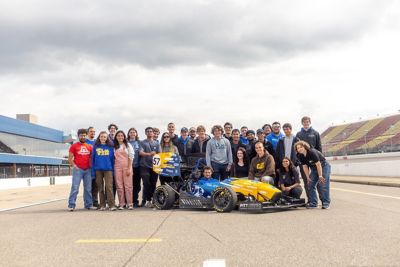
The 2023 Panther Racing team had a strong showing at the May FSAE championships, including winning the Cummins Innovation Award.
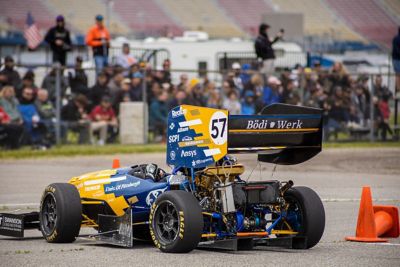
The #57 car placed 25th in the Design competition among 110 teams.
Modeling Mission-Critical Components of the Braking System with Ansys
According to Lucas Ramsey, who served as the executive director for the 2023 Panther Racing team, after 35 years Ansys continues to be a valuable tool in designing and verifying critical aspects of the car’s performance, including its braking system.
“Ansys software is used for many aspects of design” notes Ramsey. “For the 2023 season, Ansys was instrumental in designing both the car’s brake pedal and the rotors. Obviously, those are critical components of any car, especially in terms of safety.
“Our work on the brake pedal was fairly straightforward,” Ramsey says. “We needed to make sure the pedal design could accommodate every possible load case and perform successfully. Based on our finite element analysis with Ansys Mechanical, we identified critical locations with high stress levels and added material to create additional thickness at key failure points.”
Ramsey notes that Ansys helped the team tackle a much more complex problem related to the braking system’s rotors. Early in the season, the braking sub-team noticed that the rear rotors were heating up much more than the front rotors while braking. The difference in temperature— as much as 200 degrees Celsius — represented a concern from both a safety and performance perspective.
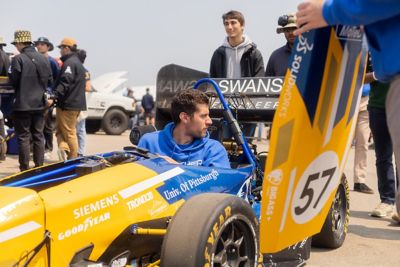
As Executive Director of Panther Racing for the 2023 season, Lucas Ramsey was in the driver’s seat — figuratively speaking.
“We were using the same rotor design in both the front and back, and we realized that we really needed to innovate with the back-rotor design to address the thermal effects,” Ramsey explains. “We needed more consistent performance across the braking system.
“We started by using Ansys Granta Selector to look at different rotor material types, which meant simply changing the material properties within Mechanical and re-simulating, knowing that every other constraint remained the same,” Ramsey states. “We were able to ask, is there any benefit from the heat side? From the stress side? Does the new material actually improve anything? And it turned out that our original material delivered the best thermal performance.”
Next, the team began evaluating the physical design of the rear rotor. “Our previous rotor design had a series of slots. We wondered what would happen if we widened those slots and turned them into holes, to increase air flow — similar to the kind of braking system you’d find on a motorcycle. Ansys Mechanical allowed us to quickly and iteratively change the size, shape, angle, and number of holes in the rotor disc.
“Ansys Mechanical also helped us verify that it was safe to remove rotor material. Since the car only weighs 500 pounds, there’s a lot less force placed on the rotors than a typical car, so we thought it would be safe. But we performed simulations to verify that the holes didn’t impact braking performance,” Ramsey emphasizes. “But they did decrease the thermal temperature of the rear rotor — first, by increasing air flow and, second, by removing material that would otherwise transmit heat.
“After modeling the new rotor design in Ansys Mechanical, we were able to verify the improved thermal performance on a real-world track,” says Ramsey. “And that’s the design we used for the #57 car this year.”
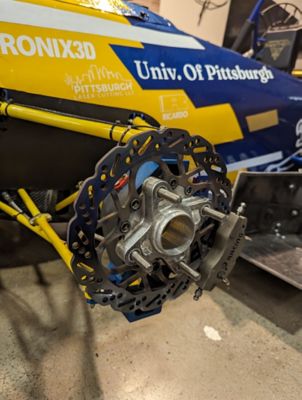
The final brake rotor Team Panther used for their car.
Accelerating the Design Cycle with Simulation
One of the engineering metrics used by FSAE judges is cost effectiveness. In May 2023, the Panther Racing team achieved 17th place for this element of their racecar design. Ramsey noted that engineering simulation not only kept costs low, but also accelerated the overall design cycle by eliminating prototypes and physical tests.
“In designing a new brake rotor, we were looking at some really complex problems like thermal buildup, friction, structural strength, and design integrity,” he points out. “You’ve got all of these things going on. And the cool thing about Ansys Mechanical is you can change up your designs without investing in an actual prototype. You can see what’s going to work and what’s going to break, without spending days or weeks on manual analysis. You can vary the geometry and immediately, visually see how the stress changes.
“That kind of rapid analysis not only saves time and costs, but it improves our ability to innovate,” he adds. “It opens up the possibility to be more creative. It allows us to test our limits. We can exponentially increase the complexity of our designs.”

A stress analysis due to the thermal loading and the forces during a braking event.

A factor-of-safety view of the stress analysis so the team could see where the weakest points were according to the simulation.
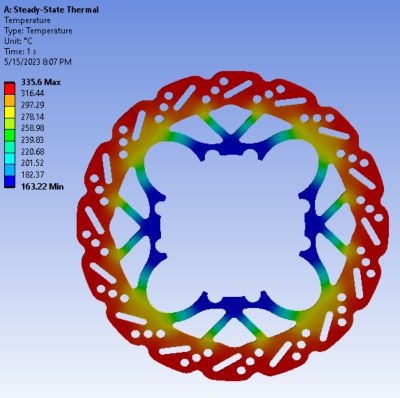
The expected temperature gradient according to the simulation setup.
Preparing for Real-World Engineering Challenges
With both a successful Formula SAE racing season and a mechanical engineering degree under his belt, today Ramsey is working as a project engineer at Honeywell Aerospace.
“At my current company, during one of my panel interviews, I discovered that half of the interviewers had experience with FSAE. This unexpected connection started a conversation unrelated to the interview but doubled our speaking time. Despite being removed from the field for several years, these individuals were still passionate about discussing race cars so the camaraderie that ensued was amazing. Undoubtedly, companies actively seek talent from the FSAE community, and possessing such simulation knowledge and experience provides a significant advantage,” Ramsey says.
“I gained a lot from learning to use Ansys software at Panther Racing, including the ability to define and answer really tough problems,” he continues. “One of the reasons I was hired at my current company is my prior experience in machining. I knew how things were made, put together, and understood all the intricate parts and quirks that one can only grasp through hands-on experience in machining and assembly. I would say as that about 90-95% of what I'm doing currently was learned from FSAE and is beneficial in industry.”
Learn more about an Ansys Student Team Partnership and request partnership of your own.










